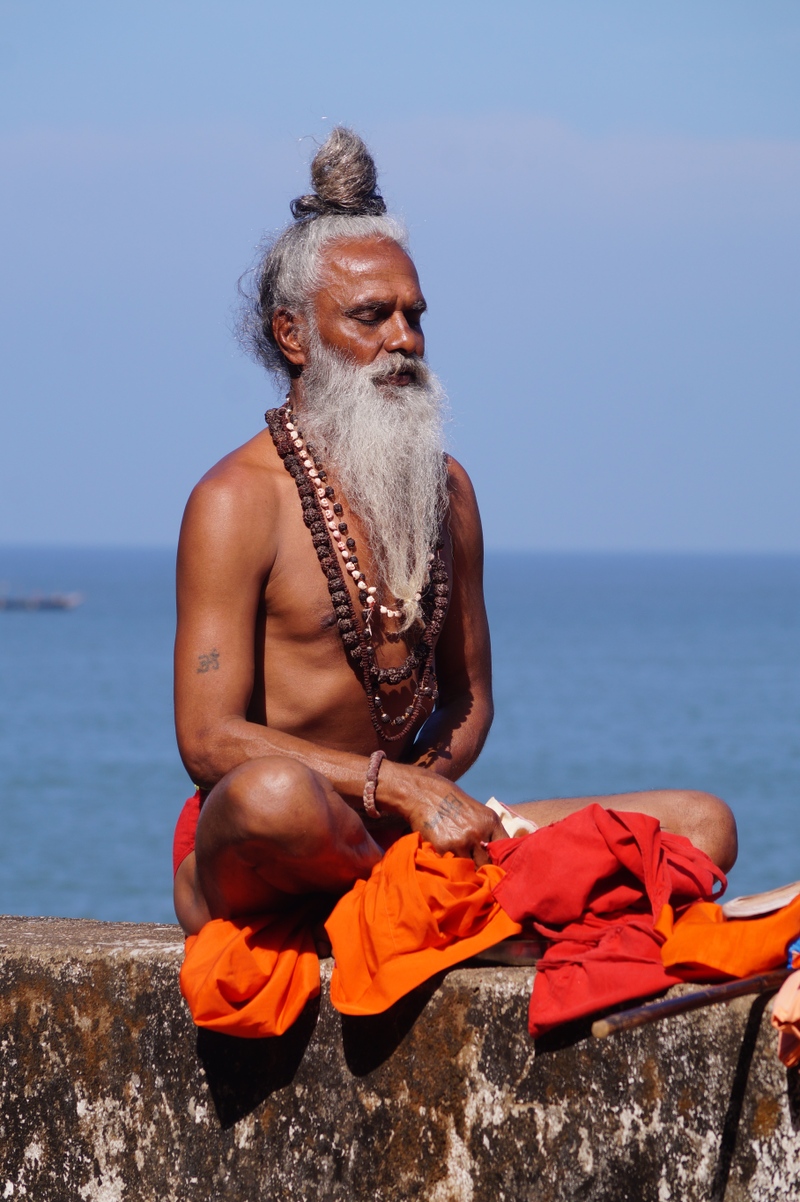The amazing Sadhu

The Amazing Sadhu

Table of Contents
Whoever visited India, was amazed by the temples, holy monuments and sacred places, many in number in this country that fascinates since ancient times.
Around these places can be found the famous "holy people" of India, known as sadhus.
Sādhu (male), sādhvī or sādhvīne (female), is a religious ascetic, mendicant or any holy person in Hinduism and Jainism who has renounced the worldly life.
Literally, it means one who practises a ″sadhana″ or keenly follows a path of spiritual discipline. Although the vast majority of sādhus are yogīs, not all yogīs are sādhus. The sādhu is solely dedicated to achieving mokṣa (liberation from the cycle of death and rebirth), the fourth and final aśrama (stage of life), through meditation and contemplation of Brahman. Sādhus often wear simple clothing, such saffron-coloured clothing in Hinduism, white or nothing in Jainism, symbolising their sannyāsa (renunciation of worldly possessions).
The term sadhu appears in Rigveda and Atharvaveda where it means "straight, right, leading straight to goal", according to Monier Monier-Williams.
In the Brahmanas layer of Vedic literature, the term connotes someone who is "well disposed, kind, willing, effective or efficient, peaceful, secure, good, virtuous, honourable, righteous, noble" depending on the context.
In the Hindu Epics, the term implies someone who is a "saint, sage, seer, holy man, virtuous, chaste, honest or right".
The Sanskrit terms sādhu ("good man") and sādhvī ("good woman") refer to renouncers who have chosen to live lives apart from or on the edges of society to focus on their own spiritual practices.
The Sādhus chose to live a life free from all social obligations, entirely devoted to the search for God. They do not have any possessions, their life is devoid of the comforts and pleasures of today's civilization.

Asceticism, which can take many forms, is one of the traditional aspects of sadhu life.
Most of those who choose the path of renunciation, practicing asceticism, are men; women make up less than 10% of all sadhus, and most of them are widows.
According to various assumptions, there are 4 to 5 million sadhus in India today. Sadhus are widely respected for their holiness. It is also thought that the austere practices of the sadhus help to burn off their karma and that of the community at large. Thus seen as benefiting society, sadhus are supported by donations from many people. However, reverence of sadhus is by no means universal in India. For example, Nath yogi sadhus have been viewed with a certain degree of suspicion particularly amongst the urban populations of India, but they have been revered and are popular in rural India.
In the past, the goods of a traditional sadhu were a vessel for food received as alms, a sacred cord, a staff, and possibly a cloth around the hips, and roamed India on foot. Currently, some of the sadhu own watches, radios, mobile phones (donated) and use public transportation.
One of the ascetic practices, and at the same time a form of Shiva worship, is to wear a jata as large as possible. This refers to the tightening of the hair, which has not been cut for at least 10 years, in narrow strands and then twisted around the head, like a tall turban.
Acquiring, maintaining and wearing a jata is in itself an ascetic practice that offers a certain important status to the sadhu, but it does not offer the guarantee of spiritual liberation, but on the contrary can promote an amplification of personal pride.
Sadhus engage in a wide variety of religious practices. Some practice asceticism and solitary meditation, while others prefer group praying, chanting or meditating. They typically live a simple lifestyle, have very few or no possessions, survive by food and drinks from leftovers that they beg for or is donated by others. Many sadhus have rules for alms collection, and do not visit the same place twice on different days to avoid bothering the residents. They generally walk or travel over distant places, homeless, visiting temples and pilgrimage centers as a part of their spiritual practice.
Celibacy is common, but some sects experiment with consensual tantric sex as a part of their practice. Sex is viewed by them as a transcendence from a personal, intimate act to something impersonal and ascetic.
The forms of asceticism followed by sadhu are varied and sometimes involve less common elements, especially for the minds of Westerners. Thus, in order to increase their faith and the power of worship, they appeal to various postures or bodily attitudes that turn into true austerities (tapas), being approached for very long periods of time.
For example, Bhagavan Das was until recently a Khareshvari, a sadhu who decided never to sit on the ground, a tapas that he followed for no less than 28 years. However, a few years ago, he gave up this tapas after receiving advice from doctors, because old age no longer provided the necessary physical endurance.
Sometimes the sadhus hold in their hands the distinctive insignia of the religious authority with which they are invested, as well as of the spiritual group to which they belong. An example of this is the tri-danda, a kind of stick made of three bamboo sticks, having the same length, closely tied together. Tri-danda symbolizes the three fundamental and correlated aspects of asceticism: perfect control of the physical body, speech, and mind. Other sadhus are accustomed to wear various objects that highlight the specifics of worship adopted by them.
The ascetic condition of a sadhu is emphasized primarily by the elements of clothing and the symbolism of the bodily attitude adopted as tapas.
It is said that through the practice of sadistic asceticism they obtain certain paranormal powers and even some spiritual achievements.
Sadhus belong to various orders or spiritual fraternities, the best known of which are those centered on the worship of Shiva and Vishnu.
Less numerous are Shakta sadhus, who are devoted to Shakti. Within these general divisions are numerous sects and subsects, reflecting different lineages and philosophical schools and traditions often referred to as "sampradayas". Each sampradaya has several "orders" called parampara based on the lineage of the founder of the order. Each sampradaya and parampara may have several monastic and martial akharas.
The color and cut of a sadhu's clothes are very different from the usual ones. The most common are red, orange, ocher or pink, worn by followers of Shaiva (worshipers of Shiva) and Vaishnava (worshipers of Vishnu).
Another order of ascetics, that of the Aghora, wears black clothes to symbolize their total renunciation and death of the profane world.
Most sadhus wear a white or yellow cotton cloth around their hips (symbols of purity and abandonment to worldly life) and a shawl over their shoulders. A sadhu never wears pants.
Some now use pieces of the shroud of the shroud in which a corpse was wrapped, after it was burned in places of cremation. Mahant Rama Narayana Das always wears like a robe, a sackcloth, and on his head a turban also made of sackcloth.
Other sadhus, however, take the clearest and most perfect form of asceticism in clothing - they walk naked. The nudity of the body places the sadhu far from the common life, from the great urban agglomerations, and this signifies the transcendence of attachments to this world.
Since their nudity is displayed without any trace of sensuality or shame, this is a testament to the sublimation of uncontrolled sexual impulses and the attainment by these sadhus of a state of calm and purity similar only to that of a child. At the same time, staying naked or only half-dressed in any season is also about assuming and achieving severe austerity.
Some sadhus always cover their naked bodies with wet ashes (eg Anghar Baba). Those in the Aghora group, such as Krishna Yogi, opt for dry ash, from the remains of the funeral pyre and, implicitly, from the corpse thus burned.
It is customary for sadhus to adopt abandoned or orphaned children, whom they meet during their pilgrimages. Madhura Das, for example, was adopted in 1953 at the age of seven by an elderly sadhu (baba) after his parents fell in the Ganges from an overcrowded bridge and drowned at one among the important religious processions at Hardwar.
Sometimes, Hindu families offer one of their children to a sadhu, so they dedicate it to a holy life, as a kind of offering to the deity worshiped by that family, when asked for help in solving problems faced by its members.
The ritual of becoming a sadhu
The processes and rituals of becoming a sadhu vary with sect; in almost all sects, a sadhu is initiated by a guru, who bestows upon the initiate a new name, as well as a mantra, (or sacred sound or phrase), which is generally known only to the sadhu and the guru and may be repeated by the initiate as part of meditative practice.
Becoming a sadhu is a path followed by millions. It is supposed to be the fourth phase in a Hindu's life, after studies, being a father and a pilgrim, but for most it is not a practical option. For a person to become sadhu needs vairagya. Vairagya means desire to achieve something by leaving the world (cutting familial, societal and earthly attachments).[citation needed]
A person who wants to become sadhu must first seek a guru. There, he or she must perform guruseva which means service. The guru decides whether the person is eligible to take sannyasa by observing the sisya (the person who wants to become a sadhu or sanyasi). If the person is eligible, guru upadesa (which means teachings) is done. Only then, the person transforms into sanyasi or sadhu. There are different types of sanyasis in India who follow different sampradya. But, all sadhus have a common goal: attaining moksha (liberation).
The complex ritual of adhering to the status of sadhu primarily involves shaving the hair on the head. Some sadhus live for a time in clay or stone huts built by their disciples, others simply take refuge under the open sky.
Festive gatherings
Kumbh Mela, a mass-gathering of sadhus from all parts of India, takes place every three years at one of four points along sacred rivers in India, including the holy River Ganges. In 2007 it was held in Nasik, Maharashtra. Peter Owen-Jones filmed one episode of "Extreme Pilgrim" there during this event. It took place again in Haridwar in 2010.
Sadhus of all sects join in this reunion. Millions of non-sadhu pilgrims also attend the festivals, and the Kumbh Mela is the largest gathering of human beings for a single religious purpose on the planet. The Kumbh Mela of 2013 started on 14 January of that year at Allahabad.[citation needed] At the festival, sadhus appear in large numbers, including those "completely naked with ash-smeared bodies, [who] sprint into the chilly waters for a dip at the crack of dawn.

Related
Benefits of Yoga Practice
Benefits of Yoga Practice
International Day of Yoga
International Day of Yoga
How yoga can help with compulsive gambling and anxiety
Gambling problems are identified with other hidden issues like nervousness, stress, impulse control problems and substance abuse. Some individuals take to betting as a method of stress relief.
Precious Stones and Our Health
Precious Stones and Our Health
Restorative Yoga As A Stress Reduction Technique
You don't have to let your money run out just because you live in a fast-paced, chaotic environment. You don't have to be depressed or worried about politics, the economy, or even everyday conflicts.
Terms & Privacy
Terms & Privacy
Best Yoga Practices to Heal The Throat Chakra
Your words are extremely important. They have the power to guide you, communicate your feelings, and tie you to another person.

